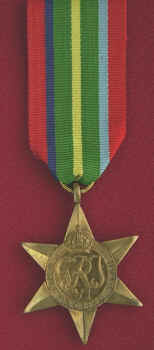Pacific Star 1941-1945:

British uniform regulations stipulated that Burma Star would not be awarded to a recipient of the Pacific Star. Subsequent entitlement to the Burma Star was denoted by the award of the Burma Star clasp. When the ribbon is worn alone a silver rosette ribbon emblem is worn to denote the award of a clasp. The Pacific Star is a six–pointed star of yellow copper zinc alloy, with a height of 44mm and a maximum width of 38mm. The obverse has a central design of the Royal Cipher of King George VI, surmounted by a crown. The cipher is surrounded by a circlet containing the words ‘The Pacific Star'.
The ribbon for this medal, along with those of the other Second World War campaign stars, is reputed to have been designed by King George VI. The jungle is represented by dark green, the beaches by the yellow stripe. The Royal Navy (and Merchant Navy), Army, and Royal Air Force are represented by stripes of dark blue, red, and light blue respectively. The Pacific Star is valued at between £30 to £35 with its value increasing by £20 if the Burma clasp is present.
The table below shows the qualifying dates required depending on the area served.
| Area | Dates |
| Hong Kong | between 8th December 1941 and 25th December 1941 |
| China and Malaya | between 8th December 1941 and 15th February 1942 |
| Sumatra | between 8th December 1941 and 23rd March 1942 |